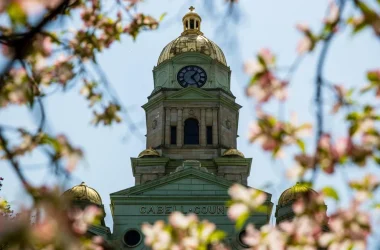By ADRANISHA STEPHENS
HARPERS FERRY, W.Va. — The Appalachian Trail Conservancy (ATC) partnered with Harpers Ferry National Historical Park for a one-mile guided hike exploring the rich African American history of Harpers Ferry.
Participants had the opportunity to learn about Storer College, the Niagara Movement and John Brown’s Raid.

(Journal photo)
“The African American History Hike was a kick-off event for this year’s anniversary,” said Laurie Potteiger, information services manager of the Appalachian Trail Conservancy. “We are right around the 150th anniversary of the founding of Storer College. The anniversary day is actually Oct. 2, but we decided to host this event because it’s a weekend and more people can come out and participate.”
Harpers Ferry National Historical Park will commemorate the150th anniversary of Storer College by hosting special events and programs that tell it’s history and recognize the legacy of the institution, which was the first school in West Virginia to welcome students of all backgrounds.
Potteiger said this is ATC’s second year hosting the event.
“We usually have about 30 to 70 people show up for these hikes, so we usually get a pretty good turnout,” Potteiger said. “This has been a really cooperative event. I worked closely with Chris Craig, who is the chair of our Trail and Town Alliance. We all worked together because Harpers Ferry is a really special place, for many reasons, but especially for the Appalachian Trail. This is the headquarters for the whole trail and it’s considered the psychological point between Maine and Georgia, at almost 2,200 miles long. It is also probably the most historic place among the whole trail and considered the most significant site to African American history.”
With the help of tour guide David Fox, visitors toured the Storer College campus and Lockwood House, explored the history of Jefferson Rock and walked the Appalachian Trail.
Fox said the Lockwood House had witnessed significant chapters in Harpers Ferry history.
“It was built in 1847 as quarters for the U.S. Army paymaster, and later served as headquarters for Union Generals Henry H. Lockwood and Philip H. Sheridan during the Civil War.”
Hikers visited Storer College next, which eventually became a college that would educate students in a southern state, regardless of color or race. Storer College opened in October of 1867 with only 19 students.
John Brown’s Raid also made a significant impact in history, according to Fox.
“Brown’s Raid made Harpers Ferry a symbol of Freedom,” Fox said. “John Brown invaded Harpers Ferry in October of 1959. His first target was the United States armory and arsenal. Brown took over the armory and arsenal and lead to a lot of division and war in this country. The reaction to the raid was kind of like a tsunami of emotion that swirled around this country, and anyone left in the middle to offer compromise–they got swept away.”
Brown said the war came to Harpers Ferry shortly after.
“Virginian soldiers took back the armory and arsenal and it was the first of eight changes of possession for this community during the American Civil War,” Fox said. “Brown paid a high price. About 45 years later, in 1906, another leader came here, his name was W. E. B. Du Bois. He came with about 150 men and women and they called themselves the ‘Niagara Movement.’”
Brown said The Niagara Movement held their first open and public meeting on American soil on Aug.15. The Niagara Movement became the cornerstone of the modern rights civil movement and was the forerunner to the NAACP.
“They were a new civil rights organization formed in secret and they wanted a place to sleep, eat, sing and pray and Storer College became that place,” Fox said. “They also came here because the John Brown History inspired them. Three years later, most of the men and women that met here helped push the NAACP forward in 1909 and into existence. So, the roots of the modern struggle for civil rights are deep in the soil of this town.”
See more from The Journal





